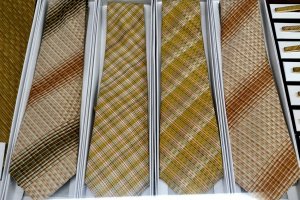Sub-tropical island Hachijojima, located nearly 300 kilometers south of Tokyo, is startlingly different from Tokyo with its palm-tree lined streets, slow pace of life, and the greeting, “Ojareyare”, in the local dialect. The island is famous as a great place for diving, whale watching, and soaking in onsens. It’s also the home of an elegant textile, kihachijo woven silk, which has lent its name to the island.
You may hear the loud clack of the looms before you notice the wooden sign at Kihachijo Meyu Workshop. The workshop has a large open studio and display space where visitors can see the craftspeople at work on this vibrantly colored fabric. At the workshop, visitors are invited to watch a brief video that reveals the long process of dying the silk threads, spinning, and weaving that result in lengths of fabric suitable for kimono and obi. What makes the fabric distinctive is the dyes derived from plants indigenous to the island. The rich yellow tone comes from kobunagasa grass, and orange from laurel. The deep black is not dependent on indigo as are other traditional dyed fabrics in Japan, but on a dye that comes from beech trees.
The fabric, a nationally recognized traditional craft unique to the island, has been sought after since the Muromachi Period. In the past, when rice was the currency used for tax payment, the islanders sent kihachijo fabric instead, as rice production on the island has always been low. Discerning kimono buyers have appreciated the sheen of the tightly woven silk for kimono, obi, and accessories. The durable fabric is washable, and as it ages, the hues deepen.
At the Kihachijo Meyu Workshop, visitors can see finished kimono, a luxury costing millions of yen. However, there are affordable products such as neckties, wallets, card cases, and swatches. Call ahead to the workshop to reserve a weaving experience with the craftspeople.




























Hachijojima is a different world from Tokyo. The island is a great place to appreciate a slower way of life. Dare I say, it's a time warp, too.
That inn in Kagawa Prefecture is enticing, too...I think I’ve got the island hopping bug.